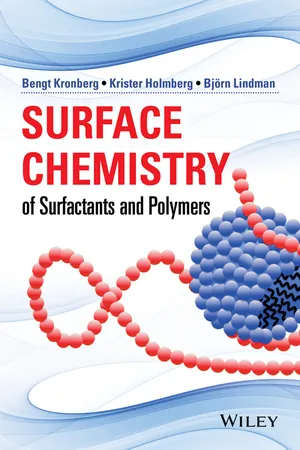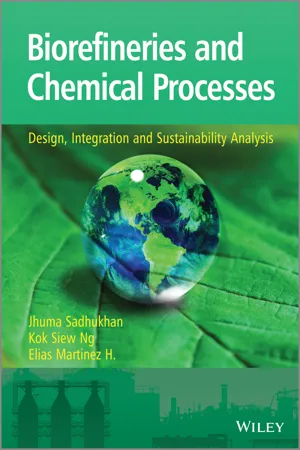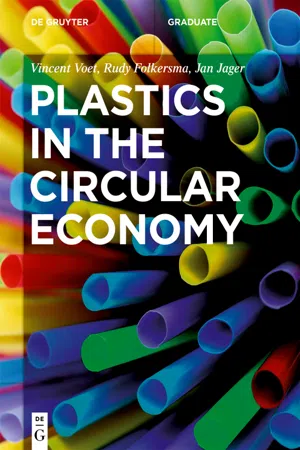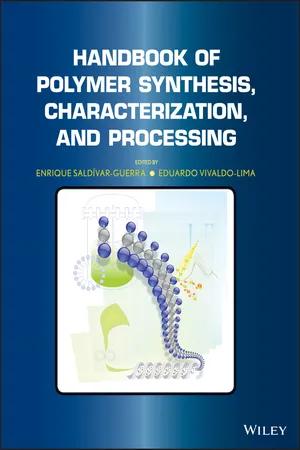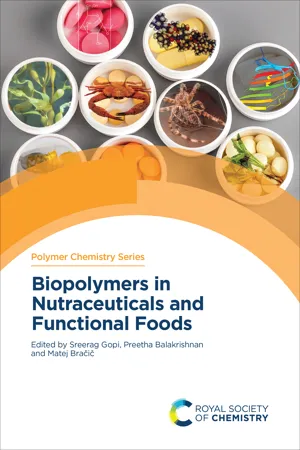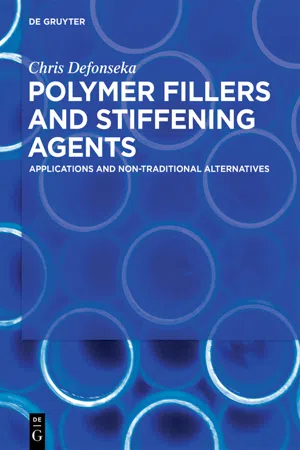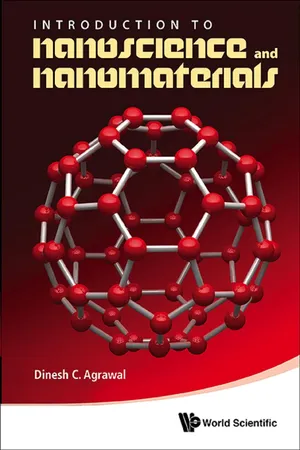Biological Sciences
Monomers and Polymers
Monomers are small molecules that can bond together to form larger molecules called polymers. In biological systems, monomers such as amino acids, nucleotides, and sugars are the building blocks of polymers like proteins, DNA, and carbohydrates. The process of polymerization involves linking monomers together through chemical bonds to create complex macromolecules with diverse functions.
Written by Perlego with AI-assistance
Related key terms
9 Key excerpts on "Monomers and Polymers"
- eBook - ePub
- Bengt Kronberg, Krister Holmberg, Bjorn Lindman(Authors)
- 2014(Publication Date)
- Wiley(Publisher)
9 Polymers in SolutionA polymer is a large molecule, a macromolecule, built up of smaller chemical units, monomers. A natural division of the science of polymers is into biological and nonbiological macromolecules. Biological macromolecules are, for example, proteins, nucleic acids, and polysaccharides while nonbiological macromolecules include the common plastics and adhesives. This chapter deals mainly with water-soluble polymers.Polymer Properties are Governed by the Choice of Monomers
Synthetic polymers are synthesized by the polymerization of monomers. The monomers in the polymerization constitute the repeat units, for example, acrylic acid is polymerized into poly(acrylic acid). A polymer can either be linear, branched, or cross-linked, as depicted in Figure 9.1 a. It is important to characterize the category a certain polymer belongs to in order to understand its solution behavior, since it differs considerably between the three categories. When only one type of monomer is used the polymer is termed homopolymer. If the polymer is synthesized with more than one kind of monomer, it is termed a copolymer. The monomer units in a copolymer can be (i) randomly distributed, (ii) distributed in blocks, or (iii) distributed such that one of the monomers is grafted in chains onto the backbone of the other monomer chain (Figure 9.1 b). Also, the solution properties and the surface chemical properties are very sensitive to which category a copolymer belongs. Some of the structures shown in Figure 9.1 b are strikingly surface active. Surface active polymers are dealt with specifically in Chapter 10 - eBook - ePub
Biorefineries and Chemical Processes
Design, Integration and Sustainability Analysis
- Jhuma Sadhukhan, Kok Siew Ng, Elias Martinez Hernandez(Authors)
- 2014(Publication Date)
- Wiley(Publisher)
12 Polymer ProcessesStructure for Lecture PlanningPolymers are present in almost every aspect of human daily life, in textiles, automobile, computer parts, insulation, food protection and packaging, etc. Polymers have contributed to energy saving and environmental impact reduction by more efficient energy use in lightweight automobiles, insulation of houses, refrigeration, etc. However, the majority of the polymers used today are produced using petrochemicals derived from fossil resources. Diminishing fossil resource and stronger market competition for production of environmentally more benign products are making companies look at innovative synthesis routes for polymer materials. This scenario, along with consumer awareness of environmental impacts of polymers, is playing an important role in the introduction of biopolymers to the market. Low cost petrochemicals like ethylene, propylene and butadiene allowed the development and innovation of fossil based polymers. Likewise, the availability of cheap biomass based building blocks or monomers and the development of polymers with more functionality and enhanced performance are crucial for successful market uptake of biopolymers.If biopolymers are going to be part of the product portfolio of a biorefinery, understanding the structures and properties of polymer and monomer and polymerization reaction kinetics is important to design reactors and integrated process flowsheets. These basic concepts are discussed in this chapter.12.1 Polymer Concepts
The literal meaning of the term polymer is many (poly) parts or units (mer). It describes the multiplicity of simple chemical units repeated in the structure of a macromolecule. The repeat unit is the basic group of atoms forming a monomer molecule. Repeat units in a polymer molecule are successively linked by covalent bonds. Obtained from a chemical precursor, a chemical formula repeatedly occurring in a polymer molecule is called the monomer. Structures of repeat units of the common polymers are shown in Table 12.1 . The number n is a large number indicating how many repeat units form a polymer molecule. This number can range from a few dozens to many thousands. This number is called the polymer chain length - eBook - ePub
- Vincent Voet, Jan Jager, Rudy Folkersma(Authors)
- 2021(Publication Date)
- De Gruyter(Publisher)
2 Introduction to polymer science2.1 Classification
The success of plastics can be attributed to their low costs and wide range of properties that can be changed by tweaking the macromolecular structure. This unique structure–property relationship will receive specific attention in the remainder of this chapter. We will start by discussing various ways to categorize polymer materials.The term polymer is derived from the Greek wordsπ o λ(polus = “many”) andυ ´ςμ(meros = “part”). Polymers can be defined as large molecules, sometimes referred to as macromolecules, composed of a large number of repeating units. The exact number required to meet the definition of a polymer depends on the size and chemical structure, but a good rule of thumb is at least 50 repeating units. Smaller molecules are named oligomers, which translates to “few parts”.ε ´ρ o ςThe building blocks that form a polymer molecule are called monomers, literally meaning “one part”. Monomers can undergo polymerization, in which they react together to form a polymer chain or network structure. Polymerizations are the subject of Section 2.3 .Considering the definition of a polymer, a tremendous amount of possibilities arise: flexible or stiff polymers, polymers derived from nature or those made in factories, polymers that absorb or repel water, polymers applied in airplanes or used in clothing, etc. To create some order, polymers are classified based on various categories, as displayed in Fig. 2.1 .Figure 2.1 Classification of polymers based on origin, chemistry, (physical) properties, polymerization route, and application.2.1.1 Origin
A wide variety of macromolecules is present in nature. Polysaccharides like starch and cellulose are formed in plants, while proteins such as silk and casein can be found in animals. Polynucleotides, known as DNA and RNA, play a crucial role in storing, coding, expressing, and regulating genetic information. While some natural polymers can be used directly as technical materials when harvested, other polymers need to be modified. For example, cellulose can be transformed into cellophane films or rayon and viscose fibers via the xanthate process. The hydroxyl groups in cellulose are modified in a basic environment, and cellulose is regenerated from viscose using acid. Also, technical rubber is produced by crosslinking latex from rubber trees via a process named vulcanization. Macromolecules made by chemically treating natural polymers are named semi-synthetic polymers [7 - eBook - ePub
Vegetable Oil-Based Polymers
Properties, Processing and Applications
- Niranjan Karak(Author)
- 2012(Publication Date)
- Woodhead Publishing(Publisher)
Polymers are composed of large molecules with a high molecular weight, unlike fine chemicals or small molecular compounds. These macromolecules are formed by covalent links of large numbers of simple repeating units with identical constituents, where the addition or subtraction of a few such units does not change the properties. The term ‘polymer’ is a combination of two Greek words: ‘poly’ meaning ‘many’ and ‘meros’ meaning ‘parts’ or ‘units’. A polymer is thus the sum of many parts or units. ‘Polymerisation’ is the process of forming polymers from their respective reactive units.The small molecules which form repeating units are known as monomers. Monomers typically react in the presence of a catalyst or initiator to form a polymer. The number of repeating units present in each polymer chain is known as the ‘degree of polymerisation’ (DP) and is used to determine the molecular weight of the polymer by the following formula:molecular weight = molecular mass of repeating unit X ‘DP’The high molecular weight of polymers is a result of the high DP, given the number of monomers in each chain.In a polymerisation process, different polymer molecules may have different numbers of repeating units in their chains and hence the chain lengths are different, even under the same set of reaction conditions in the same batch. This is because the number of reactions involved in the formation of each polymer molecule is very high, so controlling the number of repeating units in different molecules is extremely difficult. The chain length of one molecule will differ from other molecules in the same polymer. Thus the number of repeating units varies from chain to chain, even within the same batch of polymers, so only the average number is taken and the molecular weight is expressed as the average molecular weight.Biopolymers are found in animal and plant sources. Natural polymers include protein-based fibres such as wool and silk (mainly polyamide), carbohydrate fibres such as flax and cotton (mainly cellulose) as well as in tree saps which produce amber and latex (mainly hydrocarbon). The term ‘polymer’ was first coined by Berzelius in 1833. However, it was only in the 1920s that the concept of a polymer as a long sequence of repeating units linked by covalent bonds, was presented by H. Staudinger. (Nobel prize winner for chemistry, 1953).1 - Enrique Saldivar-Guerra, Eduardo Vivaldo-Lima(Authors)
- 2013(Publication Date)
- Wiley(Publisher)
Part I
Basic Concepts
Passage contains an image
Chapter 1: Introduction to Polymers and Polymer Types
Enrique Saldívar-Guerra and Eduardo Vivaldo-Lima1.1 Introduction to Polymers
1.1.1 Basic Concepts
Polymers are very large molecules, or macromolecules, formed by the union of many smaller molecules. These smaller units are termed monomers before they are converted into polymers. In fact, the word “polymer” has a Greek origin meaning “many members.” Natural polymers have been around since the early times in Planet Earth. Life itself is linked to polymers since deoxyribonucleic acid (DNA ), ribonucleic acid (RNA ), and proteins, which are essential to all known forms of life, are macromolecules. Cellulose, lignin, starch, and natural rubber are just a few other examples of natural polymers. Some of these polymers were used by early human civilizations to produce simple artifacts; for example, the play balls from natural rubber for the ball game of several of the Mesoamerican civilizations (which contained ritual content and not only entertaining purposes). In the 1800s, natural polymers began to be chemically modified to produce many materials, such as vulcanized rubber, gun cotton, and celluloid. Although natural polymers are very important, this book is mainly concerned with synthetic polymers, especially organic synthetic polymers. The chemical reaction by which polymers are synthesized from monomers is termed polymerization; however, this is a generic term, since there are a number of chemical mechanisms involved in different polymerization reactions.Synthetic polymers are relatively modern materials, since they entered into the technological and practical scene only in the first decades of the twentieth century. This makes them very different from some other materials that have been known to humanity for centuries or millennia. Also, given the fact that synthetic polymers are created by chemical reactions, the possibilities of building different polymers are virtually endless, only restricted by chemical and thermodynamic laws and by the creativity of the synthetic polymer chemist. These endless possibilities have given rise to an enormous variety of synthetic polymers that find application in almost every conceivable field of human activity that deals with matter or physical objects. In addition, the enormous molecular structural versatility that is derived from the rich synthetic possibilities, translates into materials with extremely diverse properties, and therefore applications.- Sreerag Gopi, Preetha Balakrishnan, Matej Brai, Sreerag Gopi, Preetha Balakrishnan, Matej Brai(Authors)
- 2022(Publication Date)
- Royal Society of Chemistry(Publisher)
In simple terms, polymers are derived from a large number of repeating units called monomers through chemical bonding. The number of monomers and their relative orientation might be varied to obtain different properties of polymers. Generally, polymers can be obtained from both organic and inorganic molecules. The classification of polymers may be broad, considering many aspects such as the mode of polymerization, polymeric structure, and its thermal response. However, this chapter only focuses on three different classes depending on the type of monomers or repeating units, families of the polymers, and their origins or sources.1.2.1 Based on Type of Monomer/Repeating Units
A monomer or repeating unit of small molecules is usually combined to form large molecules known as a polymer.8 The monomers are combined via a polymerization technique, either bulk, solution, suspension, or emulsion polymerization.9 ,10The number of monomers in a polymer molecule can differ significantly in terms of regularity, orientation, and different monomers in the same polymer molecule. Besides, the material properties can be altered by precisely determining the number of monomers.11 Various monomers can be synthesized to form a polymer, which can be further classified as homopolymers or copolymers.1.2.1.1 Homopolymers
A homopolymer is the simplest polymer form, which consists of only one type of monomer. The presence of a small number of impurities is negligible as long as the chemical and physical properties of the material remain the same. The homopolymer structure is illustrated in Figure 1.2 .Figure 1.2 Homopolymer structure.1.2.1.2 Copolymers
Meanwhile, a copolymer is comprised of two or more monomers in the same polymer chain.12 Copolymers exhibit different properties that depend on the monomers’ orientation. A specific property of the polymer could be achieved by modifying the sequence of monomers in the copolymer. Furthermore, copolymers can be classified into four different categories: block, alternate, random, and graft copolymers.13 Figure 1.3 illustrates these four categories for a better understanding; the repeating unit is symbolized as “X” and “Y” to explain the different arrangements. A block copolymer is produced when the monomers are clustered in alternating blocks of repeating units, as shown in Figure 1.3(a) .14 An example of a block copolymer is polystyrene-b- eBook - ePub
Polymer Fillers and Stiffening Agents
Applications and Non-traditional Alternatives
- Chris Defonseka(Author)
- 2020(Publication Date)
- De Gruyter(Publisher)
The word ‘plastics’ is derived from the Greek word ‘plastikos’. In general, a plastic can be defined as a material that is pliable and capable of being shaped by temperature and pressure. Plastics are based on polymers derived from the Greek word ‘polymeros’, with ‘poly’ meaning many, and meros meaning basic units. Polymers are also called resins in the commercial world, which is not really correct because resins are gum-like substances.Polymer chemistry is a multidisciplinary science that deals with chemical synthesis and chemical properties of polymers, which are considered to be macromolecules. Polymer chemists study the large complex molecules (polymers) that are built from smaller (sometimes repeating) units. They study how these smaller building blocks (monomers) were combined to create useful newer materials with specific characteristics. This is done by manipulating the molecular structure of the monomer/polymers used, the composition of the monomer/polymers combination, and applying chemical and processing technology that can, to a large extent, affect the properties of the final product. Polymer chemists are unique within the chemistry and scientific community because of their special knowledge and understanding of the relationships between polymer structures and their properties, spanning from the molecular to the macroscopic state.Although most polymer chemists work on applied research and development of polymers, there are opportunities for fundamental research (mainly in universities, government laboratories, and industrial labs) on theory of polymers in solid and liquid states, on the synthesis of new polymer structures, and also on the mechanical, electronic, optical, biological and other properties of those new polymers are supposed to have. Polymer chemistry and fundamental polymer research are inherently interdisciplinary, spanning chemistry, physics, engineering, economics and even biology.2.2 What are polymers?
A polymer is a large molecule (macromolecule) composed of repeating basic structural units. These subunits are typically connected by covalent chemical bonds. Although the term ‘polymer’ generally refers to plastics, it encompasses a larger class of compounds, comprising natural and synthetic materials with a wide variety of properties. Because of the extraordinary range of polymeric materials, they have essential and vital roles in everyday life of people. They broadly range from the very familiar synthetic plastics and elastomers to natural biopolymers such as nucleic acids and proteins, which are essential for life. - eBook - ePub
- James G. Speight(Author)
- 2019(Publication Date)
- Gulf Professional Publishing(Publisher)
Polymer properties are broadly divided into several classes based on the scale at which the property is defined as well as on its physical basis. The most basic property of a polymer is the identity of its constituent monomers. A second set of properties, known as microstructure, essentially describes the arrangement of these monomers within the polymer at the scale of a single chain. These basic structural properties play a major role in determining bulk physical properties of the polymer, which describe how the polymer behaves as a continuous macroscopic material. Chemical properties, at the nanoscale, describe how the chains interact through various physical forces. At the macroscale, they describe how the bulk polymer interacts with other chemicals and solvents.The identity of the monomer units comprising a polymer is the first and most important attribute. Polymer nomenclature is generally based on the type of monomer residues comprising the polymer. Polymers that contain only a single type of repeat unit are known as homopolymer (e.g., polystyrene):The repeating structural unit of most simple polymers not only reflects the monomer(s) from which the polymers are constructed but also provides a concise means for drawing structures to represent these macromolecules. For polyethylene, ethylene is the monomer, and the corresponding linear polymer is HDPE. HDPE is composed of macromolecules in which n ranges from 10,000 to 100,000 (molecular weight 2×105 3×106 ):If Y and Z represent moles of monomer and polymer respectively, Z is approximately 105 Y. The two open bonds remaining at the ends of the long chain of carbons are normally not specified because the atoms or groups found there depend on the chemical process used for polymerization. Unlike simpler pure compounds, most polymers are not composed of identical molecules. The HDPE molecules, for example, are all long carbon chains, but the lengths may vary by thousands of monomer units. Because of this, polymer molecular weights are usually given as averages.Symmetrical monomers such as ethylene can join together in only one way. Mono-substituted monomers, on the other hand, may join together in two organized ways, described in the following diagram, or in a third random manner. Most monomers of this kind, including propylene and styrene, join in a head-to-tail fashion, with some randomness occurring from time to time: - eBook - ePub
- Dinesh C Agrawal(Author)
- 2013(Publication Date)
- WSPC(Publisher)
Chapter 13 Molecules for Nanotechnology: Polymers, Biopolymers, Dendrimers and SurfactantsIn this chapter some important classes of molecules widely used in nanotechnology are briefly discussed. These are polymers and biopolymers, surfactants and dendrimers. Most of the material may be already familiar to many of the readers. Nonetheless it is thought that it should be useful to have this information readily available for refreshing the reader’s memory as well as to serve as a reference.13.1 PolymersThere are numerous applications in nanotechnology where polymers play an important role. Some examples are (i) use of polymers as key matrix materials for lithographic resists in micro and nanotechnology and in stamps as well as substrates and inks for micro contact printing (ii) exploitation of the self organization of diblock copolymers to prepare novel nanostructures (iii) self assembly of π conjugated polymers to form conducting nanowires (iv) in drug delivery and as implants and scaffolds for tissue engineering (v) for steric stabilization of nanoparticle suspensions (vi) coatings to provide protection and functionality (vii) nanoparticle–polymer composites (viii) novel applications of polymer nanoparticles.The application of polymers in nanotechnology has expanded rapidly and a new field of polymer nanotechnology is emerging. In this chapter we provide a brief introduction to some essential aspects of the polymers.13.1.1 Some common polymersPolymers are formed by linking together a large number of “monomers”. The repeat unit of a polymer is either a monomer or the monomer with a few atoms missing from it which separate out as small molecules (e.g. H2 O) during the polymerization process. In the former case the polymerization is said to be addition polymerization or chain polymerization while in the latter case it is called condensation or stepwise
Learn about this page
Index pages curate the most relevant extracts from our library of academic textbooks. They’ve been created using an in-house natural language model (NLM), each adding context and meaning to key research topics.
